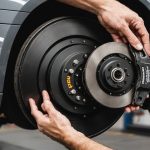Unlock your vehicle's potential with performance chips, tailored specifically for UK-spec cars. This guide offers a clear roadmap to setting up and calibrating your chip effectively, ensuring optimal performance without compromising reliability. Whether you're a seasoned enthusiast or a newcomer, understanding the intricacies of performance chips will enhance your driving experience and refine your vehicle's capabilities. Get ready to unleash greater power and efficiency as we walk you through every essential step.
Understanding Performance Chips
Performance chips are electronic devices designed to enhance a vehicle's performance by altering the engine's control unit (ECU) settings. They are a popular choice among car enthusiasts looking to improve their vehicle's power, fuel efficiency, and overall driving experience. By modifying the ECU, these chips can adjust various parameters such as fuel injection, ignition timing, and turbo boost pressure.
Also read : Unlock great deals on certified used cars in West Island
In the UK, where vehicle modifications are common, performance chips offer several benefits. They can increase horsepower and torque, leading to quicker acceleration and a more responsive engine. Additionally, some chips are designed to improve fuel economy, making them an attractive option for those looking to reduce fuel costs without sacrificing performance.
There are different types of performance chips available, each catering to specific needs and preferences. Plug-and-play chips are easy to install and can be removed without leaving a trace, making them ideal for temporary modifications. Custom-tuned chips, on the other hand, require professional installation and offer tailored adjustments based on the vehicle's specifications and the driver's requirements. Lastly, flash programmers allow users to update the ECU software themselves, providing flexibility and control over the vehicle's performance.
In the same genre : Mastering Headlight Alignment: Enhancing Visibility in Foggy UK Driving Conditions
Compatibility with UK-Spec Vehicles
Ensuring vehicle compatibility with performance chips is crucial for achieving desired enhancements without causing damage. UK-spec vehicles, designed to meet specific regulations and standards, may have unique requirements. Therefore, understanding compatibility is essential before investing in a performance chip.
Popular UK-spec vehicles, such as the Ford Fiesta, Vauxhall Astra, and Mini Cooper, often benefit significantly from performance chips. These models can experience improved horsepower, torque, and fuel efficiency when paired with the right chip. However, not all chips are suitable for every vehicle, making it important to verify compatibility.
To check compatibility before purchasing a performance chip, consider the following steps:
- Consult the vehicle's manual or manufacturer to understand the ECU specifications.
- Research and identify performance chips designed specifically for your vehicle model and year.
- Read reviews and seek recommendations from other UK-spec vehicle owners who have successfully used performance chips.
By ensuring compatibility, you can maximise the benefits of performance chips while safeguarding your vehicle's integrity. This careful consideration helps avoid potential issues and ensures a smooth upgrade process, aligning with the vehicle's design and regulatory standards.
Tools and Equipment Needed
When setting up a performance chip, having the right tools and equipment is essential for a smooth installation and optimal performance. Here's what you'll need:
-
Installation Tools: A basic toolkit including screwdrivers, pliers, and a socket set is necessary for accessing the engine's control unit (ECU). Some chips might require specific tools, so always check the manufacturer's guidelines.
-
Performance Chip Setup: For calibration, a laptop or diagnostic tool is often recommended to connect with the ECU. This allows you to tweak settings and ensure the chip is functioning correctly. Some chips come with proprietary software, so ensure your device is compatible.
-
Safety Gear and Precautions: Safety should never be overlooked. Equip yourself with gloves and safety goggles to protect against accidental injuries. Disconnect the vehicle's battery before starting the installation to prevent electrical shocks.
By using the correct installation tools and adhering to safety precautions, you can confidently enhance your vehicle's performance. Properly setting up a performance chip not only maximizes its benefits but also ensures a reliable and safe driving experience. Always refer to the chip's manual for specific instructions tailored to your vehicle's needs.
Step-by-Step Installation Process
Proper performance chip installation is key to unlocking your vehicle's potential. Begin by preparing your vehicle: ensure it's parked on a level surface and the engine is off. Disconnect the battery to avoid electrical issues during the process.
Preparing the Vehicle
Before diving into the installation guide, gather all necessary tools and safety gear. Refer to the manufacturer's instructions for any specific requirements. Ensure the ECU is accessible by removing any obstructing components.
Detailed Installation Instructions
-
Access the ECU: Locate the ECU, usually found in the engine bay or under the dashboard. Use your toolkit to carefully remove any covers.
-
Connect the Chip: Follow the installation guide specific to your chip model. Most chips connect directly to the ECU via a plug-and-play system or require additional wiring.
-
Reassemble Components: Once the chip is installed, reattach any components removed earlier. Double-check connections for security.
- Reconnect the Battery: Restore power to the vehicle by reconnecting the battery.
Common Pitfalls to Avoid
-
Ignoring Instructions: Always adhere to the installation guide to prevent damage.
-
Skipping Safety Precautions: Ensure the battery is disconnected to avoid shocks.
-
Improper Connections: Secure all connections to avoid malfunctions.
Calibration Techniques
Proper calibration techniques are crucial for achieving optimal performance from your performance chip. Calibration ensures that the adjustments made by the chip align perfectly with your vehicle's specific requirements, enhancing both power and efficiency.
Importance of Proper Calibration
Calibration is the process of fine-tuning the settings of your performance chip to match the unique characteristics of your vehicle. Without proper calibration, the chip may not deliver the expected enhancements, or worse, could lead to engine inefficiencies or damage. Performance tuning through calibration maximises the chip's benefits, ensuring your vehicle operates at its best.
Overview of Calibration Methods
There are several methods for calibrating performance chips. Manual calibration involves adjusting settings based on trial and error, often requiring a deep understanding of vehicle mechanics. Automated software tools provide a more user-friendly approach, offering pre-set configurations tailored to specific vehicle models.
Recommended Tools and Software
For effective calibration, having the right tools is essential. A diagnostic tool or a laptop with the manufacturer's software is often necessary. These tools allow you to connect to the ECU and monitor changes in real time. Some performance chips come with proprietary software, simplifying the calibration process with guided steps and recommendations.
Troubleshooting Common Issues
Encountering performance chip problems can be frustrating, but understanding how to troubleshoot can save time and stress. Identifying common issues during installation or calibration is the first step in resolving them effectively.
Identifying Common Issues
Performance chip problems often arise from improper installation or incorrect calibration. Signs include unexpected engine behaviour, reduced power, or poor fuel efficiency. If these symptoms appear, double-check the chip's connections and ensure all components are securely attached.
Solutions for Troubleshooting
To address performance chip problems, start by reviewing the installation instructions to identify any missed steps. Ensure the chip is compatible with your vehicle's ECU specifications. If calibration is the issue, recalibrate the chip using a diagnostic tool or the manufacturer's software. This process involves adjusting settings to align with your vehicle's unique requirements, enhancing performance and efficiency.
When to Seek Professional Assistance
If troubleshooting does not resolve the issue, seeking professional assistance is advisable. An experienced technician can diagnose complex problems and offer solutions that might not be apparent to the average user. This step ensures your vehicle operates safely and efficiently, maximising the benefits of your performance chip.
Measuring Performance Gains
To truly appreciate the performance gains from a performance chip, understanding and measuring these improvements is essential. Various methods and tools can help you assess the enhancements in vehicle performance.
Methods to Measure Performance Improvements
Performance gains can be quantified through vehicle performance testing. This involves evaluating parameters like horsepower, torque, and acceleration times before and after chip installation. Conducting a dynamometer test, often referred to as a "dyno" test, is a reliable method. It measures the engine's power output directly, providing accurate data on performance changes.
Tools for Performance Testing and Analysis
Several tools are available for thorough performance testing. A dynamometer is the most comprehensive, but portable diagnostic tools can also offer insights. These devices connect to the vehicle's ECU, allowing you to monitor real-time data and assess improvements in fuel efficiency and engine responsiveness.
Understanding Performance Metrics and Data
Performance metrics provide a detailed view of your vehicle's capabilities. Key metrics include horsepower, torque, and fuel efficiency. Analysing these metrics helps determine the effectiveness of the performance chip. By comparing pre- and post-installation data, you can confirm the chip's benefits and ensure your vehicle operates at its optimum level.
Legal Considerations in the UK
When considering vehicle modifications like performance chips in the UK, understanding legal regulations is crucial. The UK has specific laws governing such modifications to ensure safety and environmental compliance.
Emissions Regulations and Compliance
Performance chips can alter your vehicle's emissions, potentially breaching UK emissions standards. The law mandates that any modification must not increase emissions beyond legal limits. Non-compliance can result in fines and your vehicle failing the MOT test. It's essential to verify that the performance chip is compliant with emissions regulations before installation.
Importance of Insurance Considerations
Modifying your vehicle with a performance chip can affect your insurance policy. Insurers may view these modifications as increasing risk, potentially leading to higher premiums or even policy voidance if not declared. Always inform your insurer about any modifications to ensure your coverage remains valid. Failing to do so can result in denied claims or cancellations.
Overview of Legal Implications
In addition to emissions and insurance, other legal implications include ensuring the performance chip does not compromise safety features. Any modification should adhere to the Road Traffic Act and Construction and Use Regulations. Consulting with a professional can help navigate these legalities, ensuring your vehicle remains roadworthy and compliant.
Maintenance and Care for Performance Chips
Proper performance chip maintenance is essential to ensure your vehicle runs smoothly and efficiently. Regular checks and upkeep can prevent potential issues and prolong the chip’s lifespan.
Regular Maintenance Practices
To maintain your performance chip, start with routine inspections. Check for any loose connections or signs of wear in the wiring. It's crucial to keep the area around the chip clean and free from debris, as dust and grime can affect its performance. Additionally, software updates may be necessary to ensure the chip operates with the latest enhancements.
Signs That Maintenance is Needed
Be vigilant for any signs indicating maintenance is required. These can include unusual engine noises, decreased fuel efficiency, or a decline in performance. If you notice any of these symptoms, inspect the chip and its connections immediately.
Lifespan and Replacement Considerations
The lifespan of a performance chip can vary based on usage and maintenance. Generally, a well-maintained chip can last several years. However, if performance declines despite proper care, consider replacing the chip. Always opt for high-quality replacements to ensure compatibility and optimal vehicle performance. Regular vehicle care combined with attentive chip maintenance will keep your car running at its best.
Resources and Further Reading
For those seeking to deepen their performance chip knowledge, a variety of resources can enhance your understanding and application of these devices. Engaging with recommended books and articles on performance tuning is a great starting point. These materials often provide detailed insights into the mechanics and benefits of performance chips, offering both theoretical and practical perspectives.
Recommended Books and Articles
Books such as "Engine Management: Advanced Tuning" by Greg Banish offer a comprehensive look at tuning methods and strategies. Articles in automotive magazines and journals can also provide up-to-date information on the latest advancements in performance tuning.
Online Communities and Forums
Joining online communities and forums dedicated to performance chip enthusiasts can be incredibly beneficial. Platforms like Reddit's r/cars or dedicated automotive forums allow users to share experiences, troubleshoot issues, and exchange tips. These communities are invaluable for both beginners and seasoned enthusiasts looking to expand their knowledge and solve specific challenges.
Manufacturer Resources
For direct information, exploring links to manufacturers and installation guides can be useful. Many manufacturers provide detailed guides and FAQs on their websites, ensuring users have access to accurate and reliable information for installing and optimising their performance chips.
















